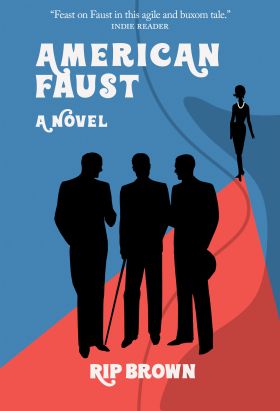American Faust
Introduction
Some novels have the power to attract a cult following. Of the more famous: The Catcher in the Rye, J.D. Salinger, On the Road, Jack Kerouac, A Confederacy of Dunces, John Kennedy Toole, Naked Lunch, William S. Burroughs. Zen and the Art of Motorcycle Maintenance, Robert M. Pirsig, Thus Spoke Zarathustra, Friedrich Wilhelm Nietzsche, and the most potent of them all, The Hobbit, JRR Tolkien. American Faust lends itself to such an audience. Sometimes mythical, other times bizarre, often shocking – everybody will have their favorite chapter or scene. This page is dedicated to those fans of American Faust who wish to take the adventure further.
American Faust is released
Worthy’s End in Devil’s Den
The Story of how Luludjka became the Spirit of the Statue.
Miserable cartographer that I am, I invite my readers to the challenge of drawing a map of the Revson Estate to include in a future edition with credit given to the winning drafter.
Since the beginning of storytelling there have been maps of imaginary worlds. There is a map of the meandering journey of Homer’s hero Ulysses from Troy to Ithaca, through the Aegean Sea, which took ten years. Or Jonathan Swift’s maps of the travels of Lemuel Gulliver to lilliput, Brufuscu and Brobdingnag in the South Sea islands off the coast of Sumatra. In fantasy fiction the more complex and diverse the worlds within a world a map is all but necessary; think the Hobbit with its map of Middle Earth. It perhaps was JRR Tolkien’s map which gave William Faulkner’s the idea to map out from his imagination the place where most of the action in his novels take place, Yoknapatawpha County, Mississippi (his publisher demanded it). A map elevates a place to a mythic dimension.
Which makes the mystical Revson Estate a perfect candidate. The property itself is one of the main characters of the novel; the way it creaks, opens its French Doors in the wind, or locks them, the hum of the pool’s filtration system, the glass greenhouse with its spinning Rooster weather vane, the front hall’s glass ceilinged atrium with its shaking crystal chandelier, the heaving of the Estate’s floor boards during the scene with the fire, not to forget the earth tremoring below the gravel drive, or the cotton white mist which covers it. In the real world the Revson Estate is a real place, with a reservoir wooded area known as Devil’s Den. This is the world where most of the story’s action takes place, in the suburban countryside of Fairfield County, Connecticut (the town I grew up in, Weston).
The novel gives dimensions of its property boundaries. There’s the fields and ponds beyond the West wall, which runs north from Old Hyde Road in the “real” running south past the enchanted Fountain Statue, to the town school’s playing fields, fenced off from the property by a row of fir trees which runs east to Eugene’s Greenhouse in the eastern corner, nestled in beside the stone wall which separates the mystical Revson Estate from the outside world to the east, surrounded by woods where Memphis Topheles makes an appearance as a deer hunter. The stone wall runs north past a grove of pines, past Sharon’s Garden, making an abrupt turn further east to the Tennis courts at the foot of the expansive front lawn with its bed of vibrantly colored flowers at its center.
With its varied themes, symbolism and topical issues, American Faust lends itself to writing a school essay on many subjects; literary devices, film inspirations, chapters based upon famous fictional works; the line between fantasy and reality; the “Metoo#” movement, male privilege and female fate, the lure of Beauty cosmetics in popular culture, biblical underpinnings and the meaning of Club Heaven and Hell, symbolism of place and the social gatherings of different time periods. The study questions for book clubs (see below) also give suggestions for paper topics. Submit your paper here, 500 words or less, and the best will be published on this site. For the very best, inclusion in a future published edition of the novel.
For aspiring writers, try your hand at writing some fan fiction! Create a story around one or more of the main characters in different time period or social gathering.

Reading Group Guide
About this guide
The questions, discussion topics, and other material that follow are intended to enhance your group’s conversation of American Faust, an enigmatic tale about the power dynamics between individuals, their reckoning with immortality and death, and the inert power within us all to find healing in the midst of a chaotic world.
Between Good and Evil
-
God consents to a bet with devil, emphasizing that James is tied to his past and could use some goading. Why would he allow the devil to test his champion?
-
At the end of the novel James says “Trusting in God is not enough. I must rely on the Devil’s advice too.” Why does he believe this? Do you agree or disagree with this idea?
-
Who do you think won the bet between the Lord and the Devil?
The Characters
- How are James and Lawrence alike in their natures? How are they different?
- Within the context of her life experience, Sharon felt her only value lay in her beauty. By the end of the novel, how did her self image change?
- James is an entrepreneur driven by a fiercely competitive nature to overcome any challenge. What cultural, gender, or experiential factors might have contributed to this developed trait?
- Was Lawrence capable of expressing genuine love? Why or why not?
- What led Eugene to rethink his relationships and his later acceptance of death?
- Timmy was wise beyond his physical age while Sally’s emotional development was stunted. In the context of the story, what might their distinct stages of development signify?
Gender Dynamics
- The novel deals with the limited roles women have had available to them in society. How do you feel this condition has changed from the 20th to the 21st century?
- In the garden scene Memphis says to Sharon “As long as men see woman as an object to possess rather than a life to imagine they shall always belong to me.” What do you think is meant by that?
- Discuss the power dynamics of the relationships in the novel. In what situation, if any, did each feel dominant? Dominated?
- What role did the Spirit of the Statue play in the lives of James and Lawrence? What affinities did she share with Sharon?
On Beauty
- In classical philosophy Truth, Goodness and Beauty are held up as the three supreme values. Do you agree? Why or why not? Discuss how each of these are portrayed in American Faust.
- In James’ encounter with the Spirit of the Statue she says “It is not I who blind your sight but your own ideal of beauty. I shall always remain invisible so long as you seek my physical perfection rather than the substance of who I am. True beauty inspires reflection of the heart, not desire of the body and mind.” Describe an experience in your life when this lesson became clear to you.
- The Revson family owns Revlon, a cosmetic company which feeds consumers’ needs to feel good about themselves through outward appearances. Discuss the commercialization of beauty and how it shapes our view of ourselves and others today.
- Does inner beauty exist? If it exists, why does it exist, and if not,why not?
Trivia
- Literary references/allusions to great works abound throughout the novel. How many (if any) were you able to identify?
- To which character(s) would you match the following items? What might each of them signify?
a) Cane
b) Chestnut
c) Sailing
d) Rifle
e) Toys
f) Thunder
g) Fire
h) Wind

About the Author
Rip Brown is a member of The Writer’s Room, New York City’s first and most acclaimed professional writers’ colony.
He studied creative writing at the Harvard Extension School, led writer’s groups and won first prize in Digital Americana’s short fiction competition with an excerpt from his novel, American Faust.
A former executive with Walmart in Mexico, Brown turned to writing serious fiction when his daughters became a manageable age. He lives and works in New York City.